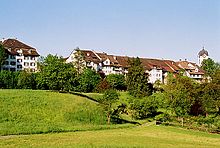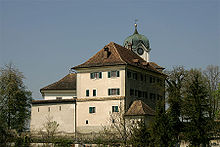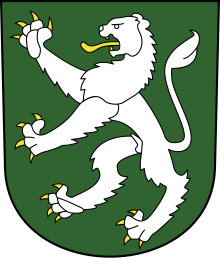Lordship of Grüningen
The rule of Grüningen emerged at the end of the late Middle Ages as a Regensberg foundation and existed until 1798. Between 1406 and 1416 and 1798, Grüningen was a Landvogtei ("Äussere Vogtei") of the city of Zurich .
history
Rapperswiler and Kyburger (around 1217–53)
Is documented in Grüningen Einkünfte- Urbar of Einsiedeln monastery in the years 1217-22. Castvögte of the monastery were the Rapperswiler , and therefore it is assumed that they laid the foundation stone for Grüningen Castle around 1220.
Around 1230, Einsiedeln Monastery lost its property around Grüningen to St. Gallen Monastery , which initially pledged the area to the Count of Kyburg . In 1243 a kyburgischer should bailiff be secured documented in Grüningen.
Regensbergers and Habsburgs (1253–1406)
- Main article: Regensberger
In 1253 the monastery of St. Gallen transferred the bailiwick rights over Grüningen together with the courts of Dürnten and Altorf to Lüthold VI. from Regensberg. In the same period, the development of the town in front of the castle is dated, and the process of town development is assigned to the Regensbergers. The town and castle Grüningen were developed as an administrative center and one of the most important possessions of the Regensberg family . In 1260 the Regensbergers exempted the neighboring monastery of Rüti from taxes to Grüningen.


- Main article: Regensberg feud
In connection with the so-called Regensberg feud , Lüthold VI. von Regensberg returned the Grüninger fiefdom to the monastery of St. Gallen in 1269, which pledged the castle and rule to his ministerial Walter von Elgg in 1273 . Rudolf von Habsburg , who was crowned German king in the same year, secured the rule of Grüningen a year later, between 1273 and 1284.
At the beginning of the 14th century the administration was transferred to the Count of Habsburg-Laufenburg . In 1314 the Counts of Toggenburg were employed as carers . As a forward southern base, Grüningen became increasingly important in connection with the territorial disputes between Habsburg Austria and the Swiss Confederation .
In 1374 Grüningen was pledged to the Austrian field captain, knight and chamberlain Heinrich Gessler from Meienberg in Aargau , who expanded the fortifications of the castle. Grüningen was not directly in the combat area of the Sempach War (1364-89), but Zurich troops undertook individual raids into Habsburg areas, and so Grüningen was also devastated. Another campaign to the Grüninger office took place in 1388 ( Battle of Näfels ).
Landvogtei Grüningen (1406–1798)
- Main article: Territorial development of Zurich
After Heinrich Gessler died in 1403, his son Hermann Gessler took over the successor, but ran into financial difficulties due to ongoing defensive battles against Zurich. The brothers Hermann and Wilhelm Gessler pledged the rule Grüningen in 1406 (or 1408) to the city of Zurich without having obtained the authorization of Habsburg. The House of Habsburg repeatedly tried to redeem the pledged area and thus regain possession of its strategically important western outpost. The Zurich council leased the rulership to the couple Heinrich and Anna Hagnauer. After consolidating the confused political situation following the conquest of the Aargau , Heinrich Hagnauer was elected Vogt in 1416 and Grüningen was administered as the outer bailiwick of the city of Zurich.
The incorporation of the Grüningen rule into the Zurich city-state was by no means free of conflict. Relations between the new authorities and the rural population are said to have been very tense from the start, as the Zurich bailiff is said to have exercised a strict rule over the landscape and restricted the rights of the population compared to the Habsburg rule.
Old Zurich War
- Main article: Old Zurich War
During the Old Zurich War (1436–50), 1,100 people from Schwyz and Glarus moved to the Grüninger office at the beginning of November 1440 and besieged the town and castle, which was defended by Vogt Jakob Murer with 40 men. A messenger to Zurich who asked for reinforcements returned to Grüningen without having achieved anything, and so the resistance from the Grüningen was low. On November 10, 1440, the office and town and eight days later the castle were in the hands of the Confederates without a fight.
Confederate troops plundered and devastated the possessions of Zurich to the left and right of Lake Zurich, except for the mediation of Count Hugo von Montfort, a peace was concluded in Kilchberg in November , which was chartered in Lucerne on December 1, 1440. The conditions meant a complete defeat for Zurich. In this extremely bad situation for Zurich in 1441, the German king, Friedrich III. von Habsburg, as well as the return of the rule Grüningen. Through Bern's mediation, Grüningen received a special legal status, recorded in the so-called "Berner Spruch" of March 17, 1441.
From June 11 to 16, 1443, the eight old towns besieged the castle and town of Grüningen for the second time, and the majority of the defenders advocated surrender. Despite the assurance of safe conduct, Vogt Peter Kilchmann was killed by an Unterwald man. In the second half of June 1443, as night fell, more than forty men of the Grüningen garrison appeared in front of the city gate of Rapperswil and asked to be admitted. However, they were refused entry because they “had not honestly and honestly maintained Grüningen as a Zurich property. They now had to spend the whole night outside the city of Rapperswil; The Rosenstadters only let the gunsmith in because he had apologized that he was not to blame for the surrender of Grüningen. The following day, the Grüninger team moved on to Zurich, where they were immediately put in prison and severely fined. »
Central Swiss army under the Schwyzer Landammann Ital Reding the Elder invaded the city of Zurich's hinterland ( Landvogteien Grüningen and Greifensee ) after the unsuccessful peace negotiations in Baden at the end of April 1444 . On May 1st, 1444, they reached the town of Greifensee and besieged it for four weeks. After bitter fighting, on May 28, 1444, the surviving crew of Greifensee was beheaded with a sword by the Confederates on the "Blood Mat" in Nänikon and Greifensee was largely destroyed ( murder of Greifensee ).
On August 24, 1450, Zurich and the other confederates solemnly renewed the old leagues by oath in a meadow near Einsiedeln Monastery and exchanged the flags captured in the war. This also formally ended the Old Zurich War, and Grüningen definitely became Zurich's dominion.
Outer Bailiwick of Zurich


In the years that followed, Zurich consolidated its hegemony in the office of Grüningen, also known as rule or office. The office bordered on Thurgau, Toggenburg, Uznach, Rapperswil and the Zurich bailiffs Greifensee , Kyburg and the Obervogtei Stäfa. The Grüningen rule comprised 17 castles, two monasteries and 13 parishes.
During the Waldmann trade ( Waldmannsche Spruchbriefe ) in the spring of 1489, the Grüninger successfully asserted themselves against the unification of the law.
- Main article: Reformation and Counter-Reformation in Switzerland
In the peasant unrest of 1525 , they refused to pay rulership taxes to the city of Zurich. The Anabaptist movement also found great support among the people of the Landvogtei.
Helveticism, mediation and restoration (1798–1830)
- Main article: Helvetic Republic
After the French Revolution , the end of the order of the old Confederation and the city-state of Zurich was in sight. With the military occupation of Stäfa (so-called Stäfner Handel ), Zurich tried to stop this development in 1795. The declaration of complete freedom and equality between town and country by a decree of the Grand Council on February 5, 1798 came too late, however, and French revolutionary troops marched into the Confederation. On March 13, 1798, the Zurich council abdicated, the bailiffs were abolished, and the last bailiff in office since 1792, Heinrich Lavater, left Grüningen.
The territory of the city of Zurich was divided into 15 districts. Part of the former Landvogtei Grüningen was raised to a Helvetic district with the main town Grüningen and the communities Bubikon, Gossau, Oetwil, Egg, Mönchaltorf, Rüti and Dürnten. Each district had a governor and a court of nine members, and each parish an agent.
- Main article: Mediation (history)
The end of the unitary state and the Helvetian Directory came after just five years. On February 19, 1803, the mediation act was handed over to Switzerland in Paris.
The canton of Zurich was now divided into five districts, each with 13 guilds . Grüningen came to the Uster mediation district together with Gossau, Wetzikon, Wald, Fischenthal and Hinwil. During this time the foundations of today's community organization of the political community were created.
- Main article: Restoration (Switzerland)
As a result of Napoleon's final defeat, conservative circles regained the upper hand from 1814 to 1830 and tried to partially re-establish the order that had prevailed before the invasion of the revolutionary troops. Today's canton of Zurich was divided into eleven senior offices, each of which was headed by a senior official. His position corresponded to that of the earlier governors. In his area of responsibility, administration and administration of justice were reunited and the separation of powers from the mediation period was thus partially reversed, even if a district court belonged to the higher office, but the upper bailiff was its president. Grüningen again became the capital. The municipalities Grüningen, Wetzikon, Gossau, Bubikon, Rüti, Hinwil, Dürnten, Wald, Fischenthal and Bäretswil belonged to the Oberamt Grüningen, with the official and residence of the Oberamtmann in Schloss Grüningen.
From the Greifensee office to the Hinwil district (1830)
- Main article: Regeneration (Swiss history)
In 1830 the people of Zurich called for reforms and demanded complete equality between the city and the countryside. At a people's assembly on November 22nd in Uster, demands were made in a memorial. Due to popular pressure, elections to the new Grand Council took place on December 6, 1830. Only three months later, on March 20, 1831, there was a referendum on the new cantonal constitution, which was approved by an overwhelming majority of those entitled to vote.
With the referendum of March 20, 1831, the upper offices were canceled. The municipalities of the hitherto Oberamt Grüningen formed the new District Hinwil - district capital was Hinwil .
Organization, administration and jurisdiction (Landvogtei)
Organization and administration
The city of Zurich administered the rule Grüningen as the so-called "outer bailiwick". A bailiff resided at Grüningen Castle and exercised the power of rule on behalf of Zurich. Usually, the bailiff was a member of the Grand Council of the City of Zurich, which, however, resigned from the council for the term of office. In contrast to the upper bailiffs, there was a residence obligation for the bailiffs in the bailiwick. The term of office of the bailiffs was six years from 1543, a second term of office was excluded. Two senior bailiffs also held office in the Outer Bailiwicks on an annual basis, and the two replacing bailiffs have held collegial office since the 16th century. Their term of office was not limited.
Grüningen Castle was the seat and residence of the governors appointed by the Grand Council of Zurich. These all came from influential and important urban bourgeois families. The provincial bailiffs had to fulfill their office in representation of the city of Zurich authorities and had to adhere to the legal system set by Zurich and ensure that it was observed. They were the highest judicial and administrative body at the same time. Depending on the personality of the respective governor, the exercise of their office was quite different. From 1408 to 1798 66 governors resided in the castle.
There were 17 castles, the monastery of Rüti , the Johanniterkommende Bubikon and 13 parishes:
- Bäretswil
- Bubikon
- Dürnten
- Egg
- Fischenthal
- Gossau
- Grüningen
- Hinwil
- Hombrechtikon
- Mönchaltorf
- Rüti ( Office Rüti )
- Forest
- Wetzikon and today's district of Kempten
- Enclaves: Dingstatt Binzikon (municipality of Grüningen), Greifenberg (municipality of Bäretswil)
jurisdiction
The rulers' court exercised the upper jurisdiction, the lower jurisdictions were open to the jurisdictions of Greifenberg ( Bäretswil ), Kempten and Wetzikon. The four court courts of Dürnten, Mönchaltorf, Wald and Fischenthal as well as the Dingstatt Binzikon (municipality of Grüningen), to which seven villages / hamlets belonged, also came from the early Middle Ages. The ruling court, however, increasingly ousted the court courts .
The following jurisdictions existed within the Landvogtei, in which the lower jurisdiction was temporarily or permanently not in the possession of the City of Zurich:
- Herrschaft Greifenberg (as a fief of the St. Gallen monastery with the barons of Hinwil, later with the Schmid from Zurich)
- Wernetshausen (2/3 owned by the barons of Hinwil)
- Wetzikon (with horns as exclave in the Landvogtei Kyburg owned by the Lords of Breitenlandenberg, later the Meiss from Zurich)
- Kempten (owned by the Blarer von Wartensee from Zurich, later with the Schmid from Zurich)
- Herrschaft Bubikon (with Hinwil and Grüt, owned by the Order of St. John until 1789)
- Rüti (with Oberdürnten, Fägswil, Tägernau, owned by Rüti Monastery until 1525, then Rüti Office )
Due to the heterogeneous composition of the rulers, different openings and special rights applied: The Dingstatt Rodel von Binzikon (1435) for the core of the rulership, the Hofrodel von Dürnten (1480) and the Hofrödel von Fischenthal and Wald go back in part to the Austrian rule. In the 16th century the court of the twelve in Grüningen is mentioned, the later rulership court, which replaced the late medieval court courts. The blood jurisdiction lay with the parliament - an appellation way to the Zurich council did not exist. The private law has been unified only with the Grüninger Office of Legal 1668th
coat of arms
- Blazon : In green a soaring silver, gold-tongued and armored lion
The lion as an animal on the municipal coat of arms can be identified for the first time on a seal in 1370. The heraldic animal can probably be traced back to the Habsburg lion, because Grüningen was Austrian from 1274–1408. The green background indicates the name Grüningen. The city coat of arms also corresponds to that of the later Zurich Landvogtei. All contemporary documents ( heraldic books, heraldic disks , maps, seals, etc.) show the lion on the green background.
See also
literature
- Doris Klee: Communicating Conflicts: The Letters of the Grüninger Landvogts Jörg Berger to the Zurich Council (1514-1529) . Dissertation , Chronos, Zurich 2006. ISBN 3-0340-0775-2
- Marco AR Leutenegger: City and Population History of Grüningen in the Late Middle Ages: Selected Aspects . Dissertation, ed. Heimatschutzgesellschaft Grüningen, Juris Druck + Verlag, Zurich 1989. ISBN 3-260-05251-8
- T. Weibel: Inheritance law, judiciary and serfdom in the Landvogtei Grüningen . 1987.
- G. Strickler: History of the rule Grüningen comprising the 16 communities [...] Seegräben [..]. That is the story of the Zurich Oberland and its relationship with the city of Zurich and the lake. Orell Füssli , Zurich 1908.
Web links
- Website of the community of Grüningen: history
- Grüningen Castle
- Martin Illi: Grüningen (rule, bailiwick). In: Historical Lexicon of Switzerland .
Individual evidence
- ↑ a b c d e f g h i j k l m website of the municipality of Grüningen
- ↑ a b c d e Martin Illi: Grüningen (rule, bailiwick). In: Historical Lexicon of Switzerland .
- ↑ Swisscastles.ch Schloss Grüningen
- ^ History of the Canton of Zurich, Vol. 2, p. 38f.
- ↑ Dingstatt: place of the day of judgment
- ↑ Representation used from contemporary maps and coats of arms, see Rhyner Collection ( Memento of the original of May 24, 2008 in the Internet Archive ) Info: The archive link was inserted automatically and has not yet been checked. Please check the original and archive link according to the instructions and then remove this notice.
Coordinates: 47 ° 17 '5 " N , 8 ° 45' 43.4" E ; CH1903: 700,117 / 237936






